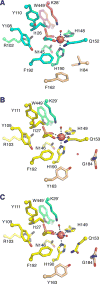Structural basis for methylphosphonate biosynthesis
- PMID: 29217579
- PMCID: PMC5901744
- DOI: 10.1126/science.aao3435
Structural basis for methylphosphonate biosynthesis
Abstract
Methylphosphonate synthase (MPnS) produces methylphosphonate, a metabolic precursor to methane in the upper ocean. Here, we determine a 2.35-angstrom resolution structure of MPnS and discover that it has an unusual 2-histidine-1-glutamine iron-coordinating triad. We further solve the structure of a related enzyme, hydroxyethylphosphonate dioxygenase from Streptomyces albus (SaHEPD), and find that it displays the same motif. SaHEPD can be converted into an MPnS by mutation of glutamine-adjacent residues, identifying the molecular requirements for methylphosphonate synthesis. Using these sequence markers, we find numerous putative MPnSs in marine microbiomes and confirm that MPnS is present in the abundant Pelagibacter ubique. The ubiquity of MPnS-containing microbes supports the proposal that methylphosphonate is a source of methane in the upper, aerobic ocean, where phosphorus-starved microbes catabolize methylphosphonate for its phosphorus.
Copyright © 2017 The Authors, some rights reserved; exclusive licensee American Association for the Advancement of Science. No claim to original U.S. Government Works.
Figures




References
-
- Scranton MI, Brewer PG. Occurrence of methane in the near-surface waters of the western subtropical North-Atlantic. Deep Sea Research. 1977;24:127–138.
-
- Holmes ME. Methane production, consumption, and air-sea exchange in the open ocean: An evaluation based on carbon isotopic ratios M. Elizabeth Holmes, 1 Francis J. Sansone, Terri M. Rust, and Brian N. Popp. Global Biogeochemical Cycles. 2000;14:1–10.
-
- Liu Y, Whitman WB. Metabolic, phylogenetic, and ecological diversity of the methanogenic archaea. Annals of the New York Academy of Sciences. 2008;1125:171–189. - PubMed
-
- Karl DM, Tilbrook BD. Production and transport of methane in oceanic particulate organic matter. Nature. 1994;368:732–734.
-
- Rogers JE, Whitman WB. Microbial production and consumption of greenhouse gases: methane, nitrogen oxides, and halomethanes. 1991
Publication types
MeSH terms
Substances
Grants and funding
LinkOut - more resources
Full Text Sources
Other Literature Sources
Molecular Biology Databases

